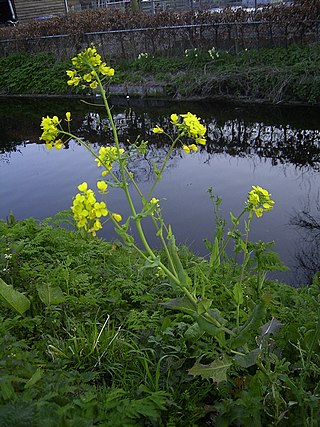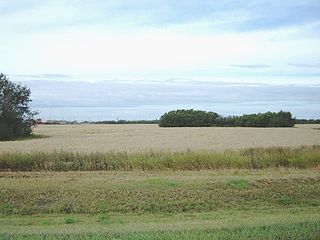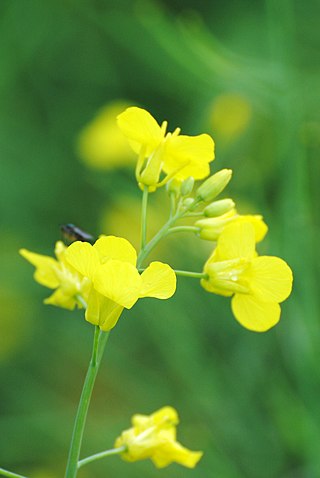
Rapeseed, also known as rape, or oilseed rape, is a bright-yellow flowering member of the family Brassicaceae, cultivated mainly for its oil-rich seed, which naturally contains appreciable amounts of erucic acid. The term "canola" denotes a group of rapeseed cultivars that were bred to have very low levels of erucic acid and which are especially prized for use as human and animal food. Rapeseed is the third-largest source of vegetable oil and the second-largest source of protein meal in the world.

The University of Saskatchewan is a Canadian public research university, founded on March 19, 1907, and located on the east side of the South Saskatchewan River in Saskatoon, Saskatchewan, Canada. An "Act to establish and incorporate a University for the Province of Saskatchewan" was passed by the provincial legislature in 1907. It established the provincial university on March 19, 1907 "for the purpose of providing facilities for higher education in all its branches and enabling all persons without regard to race, creed or religion to take the fullest advantage". The University of Saskatchewan is the largest education institution in the Canadian province of Saskatchewan. The University of Saskatchewan is one of Canada's top research universities and is a member of the U15 Group of Canadian Research Universities.
Baldur Rosmund Stefansson, was a Canadian agricultural scientist and as one of the originators of canola, became known as the "Father of Canola".

Brassica rapa is a plant species growing in various widely cultivated forms including the turnip ; Komatsuna, napa cabbage, bomdong, bok choy, and rapini.
Monsanto Canada Inc v Schmeiser [2004] 1 S.C.R. 902, 2004 SCC 34 is a leading Supreme Court of Canada case on patent rights for biotechnology, between a Canadian canola farmer, Percy Schmeiser, and the agricultural biotechnology company Monsanto. The court heard the question of whether Schmeiser's intentionally growing genetically modified plants constituted "use" of Monsanto's patented genetically modified plant cells. By a 5-4 majority, the court ruled that it did. The Supreme Court also ruled 9-0 that Schmeiser did not have to pay Monsanto their technology use fee, damages or costs, as Schmeiser did not receive any benefit from the technology. The case drew worldwide attention and is widely misunderstood to concern what happens when farmers' fields are accidentally contaminated with patented seed. However, by the time the case went to trial, all claims of accidental contamination had been dropped; the court only considered the GM canola in Schmeiser's fields, which Schmeiser had intentionally concentrated and planted. Schmeiser did not put forward any defence of accidental contamination.

Canada is one of the largest agricultural producers and exporters in the world. As with other developed nations, the proportion of the population agriculture employed and agricultural GDP as a percentage of the national GDP fell dramatically over the 20th century, but it remains an important element of the Canadian economy. A wide range of agriculture is practised in Canada, from sprawling wheat fields of the prairies to summer produce of the Okanagan valley. In the federal government, overview of Canadian agriculture is the responsibility of the Department of Agriculture and Agri-Food.

Agriculture in Saskatchewan is the production of various food, feed, or fiber commodities to fulfill domestic and international human and animal sustenance needs. The newest agricultural economy to be developed in renewable biofuel production or agricultural biomass which is marketed as ethanol or biodiesel. Plant cultivation and livestock production have abandoned subsistence agricultural practices in favor of intensive technological farming resulting in cash crops which contribute to the economy of Saskatchewan. The particular commodity produced is dependent upon its particular biogeography or ecozone of Geography of Saskatchewan. Agricultural techniques and activities have evolved over the years. The first nation nomadic hunter-gatherer lifestyle and the early immigrant ox and plow farmer proving up on his quarter section of land in no way resemble the present farmer operating huge amounts of land or livestock with their attendant technological mechanization. Challenges to the future of Saskatchewan agriculture include developing sustainable water management strategies for a cyclical drought prone climate in south western Saskatchewan, updating dryland farming techniques, stabilizing organic definitions or protocols and the decision to grow, or not to grow genetically modified foods. Domestically and internationally, some commodities have faced increased scrutiny from disease and the ensuing marketing issues.

The College of Agriculture and Bioresources is a faculty at the University of Saskatchewan in Saskatoon, Saskatchewan.
Richardson International Limited is a privately held Canadian agricultural and food industry company headquartered in Winnipeg, Manitoba. The company is one of several companies that are owned by James Richardson & Sons Limited. The company is a worldwide handler and merchandiser of all major Canadian-grown grains and oilseeds and a vertically integrated processor and manufacturer of oats and canola-based products. Richardson has over 2,500 employees across Canada, the U.S. and U.K. Richardson International is a subsidiary of James Richardson & Sons, Limited, established in 1857.
The economy of Saskatchewan has been associated with agriculture resulting in the moniker "Bread Basket of Canada" and Bread Basket of the World. According to the Government of Saskatchewan, approximately 95% of all items produced in Saskatchewan, depend on the basic resources available within the province. Various grains, livestock, oil and gas, potash, uranium, wood and their spin off industries fuel the economy.

A grain is a small, hard, dry fruit (caryopsis) – with or without an attached hull layer – harvested for human or animal consumption. A grain crop is a grain-producing plant. The two main types of commercial grain crops are cereals and legumes.
Elizabeth Pattey is a principal research scientist at Agriculture and Agri-Food Canada (AAFC) and the leader of the micrometeorology laboratory at the Ottawa Research and Development Centre. Her research supports nationwide improvement in the environmental performance of agriculture, in support of the United Nations' Framework Convention on Climate Change and Canada’s Clean Air Act. She is the co-author for over 80 peer-reviewed scientific publications, and her areas of expertise include trace gas flux measurement techniques, process-based models, and remote-sensing applications.
Barbara Jane Howlett is an Australian fungal plant pathologist.
Vernon Douglas Burrows was a research scientist at Agriculture and Agri-Food Canada (AAFC) and an international authority on oat breeding and utilization. He bred and registered 28 varieties of oats, including AC Gehl, the “naked oat,” which is hulless and hairless and therefore easier to process and transport. In 2001 Burrows was appointed as Member of the Order of Canada, and in 2018 he was promoted to Officer of the Order of Canada for his research that has enhanced the production and nutritional value of oat-based foods.
Cynthia Grant, Ph.D., is a former Canadian federal scientist who is internationally recognized as an expert in soil fertility and crop nutrition. A researcher with Agriculture and Agri-Food Canada (AAFC) (1986-2015), she is highly respected by industry, farmers, and public agencies alike. Her research provided the scientific foundation for the Made-in-Canada 4R nutrient stewardship framework that applies crop nutrients from the right source and at the right rate, time and place. Grant is now part of an elite group of ten women who have been inducted into the Canadian Agricultural Hall of Fame since 1960.
Isobel Parkin Ph.D. is a Canadian research scientist with Agriculture and Agri-Food Canada. She is one of the world's premier canola scientists and her area of expertise focuses on brassica genomics, comparative genome organization, global gene expression analysis, and abiotic stress responses. She is well known for her work on an international project on the genetics of oil seeds, in particular the mapping and sequencing of the canola oil genome. She Co-lead the Canadian Canola Genome Sequence (CanSeq) team that successfully deciphered the canola genome and developed a high-quality genome sequence.
Jennifer Mitchell Fetch is a Canadian research scientist with Agriculture and Agri-Food Canada (AAFC) with expertise in oat breeding. She is known for running the only organic oat breeding program in Canada and helping with the development of several oat milling quality cultivars, including the first organically developed cultivar, AAC Oravena. Canada is the largest exporter of oats in the world, emphasizing the importance of developing new and improved cultivars for farmers. Canada is responsible for producing approximately 3 million tonnes of quality oats every year, with 90% being from Western Canada, where Mitchell Fetch focused her research and was the only Agriculture Canada oat breeder for years. Mitchell Fetch was employed by AAFC in 1998 and spent 22 years as an oat breeder before her retirement in 2020.
Guy Lafond was a research scientist for over 30 years with Agriculture and Agri-Food Canada at the Indian Head Research Farm in Saskatchewan. He was instrumental in establishing the Indian Head Agricultural Research Foundation (IHARF) in the early 1990s and had a major impact on cropping practices and soil conservation.
Constantine Campbell is a Canadian scientist who is a researcher in soil organic matter and all features of nitrogen in soils and crops. Campbell is the leading authority on soil fertility and degradation of nitrogen in American prairie soil, which includes the amount of loss on the quality of organic matter. He was one of the first to radiocarbon date soil organic matter, and in 1967 published a paper which is cited as a landmark work. Majority of his career, he worked with Agriculture Canada in Swift Current, Saskatchewan, retiring in 1998.

Rapeseed oil is one of the oldest known vegetable oils. There are both edible and industrial forms produced from rapeseed, the seed of several cultivars of the plant family Brassicaceae. Historically, it was restricted as a food oil due to its content of erucic acid, which in laboratory studies was shown to be damaging to the cardiac muscle of laboratory animals in high quantities and which imparts a bitter taste, and glucosinolates, which made it less nutritious in animal feed. Rapeseed oil from standard cultivars can contain up to 54% erucic acid.







